Application of Simultaneous Symmetric and Cambered Airfoils in Novel Vertical Axis Wind Turbines
Abstract
:1. Introduction
2. Case Study
3. Methodology
3.1. Numerical Domain
3.2. Mesh and Timestep Independency
3.3. Solution Method
3.4. Validation
4. Results and Discussion
4.1. Power Production
4.2. Dynamic Stall Phenomena
4.3. Self-Starting Ability
4.4. Overall Performance Analysis
5. Conclusions
Author Contributions
Funding
Institutional Review Board Statement
Informed Consent Statement
Data Availability Statement
Conflicts of Interest
Nomenclature
| Parameters | ||
| Rg | Rotating domain radius | m |
| Δx | Spatial discretization | m |
| CP | Power coefficient | - |
| CT | Torque coefficient | - |
| Rec | Reynolds based on chord length | - |
| U∞ | Freestream velocity | m/s |
| C | Chord length | m |
| Subscripts and abbreviations | ||
| CFL | Courant–Friedrichs–Lewy number | |
| VAWT | Vertical axis wind turbine | |
| NSA | Non-Similar Airfoil | |
| HT | H-type | |
| Greek letters | ||
| Azimuthal angle changes in a time step | Rad | |
| Rotating grid tip speed ratio | - | |
| Tip speed ratio (TSR) | - | |
| Kinematic viscosity | ||
| Wind turbine azimuthal angle | Degree | |
References
- Koroneos, C.; Spachos, T.; Moussiopoulos, N. Exergy analysis of renewable energy sources. Renew. Energy 2003, 28, 295–310. [Google Scholar] [CrossRef]
- Jin, X.; Zhao, G.; Gao, K.; Ju, W. Darrieus vertical axis wind turbine: Basic research methods. Renew. Sustain. Energy Rev. 2015, 42, 212–225. [Google Scholar] [CrossRef]
- Elsakka, M.M.; Ingham, D.B.; Ma, L.; Pourkashanian, M. CFD analysis of the angle of attack for a vertical axis wind turbine blade. Energy Convers. Manag. 2019, 182, 154–165. [Google Scholar] [CrossRef]
- Li, Y.; Zhao, S.; Tagawa, K.; Feng, F. Starting performance effect of a truncated-cone-shaped wind gathering device on small-scale straight-bladed vertical axis wind turbine. Energy Convers. Manag. 2018, 167, 70–80. [Google Scholar] [CrossRef]
- Dominy, R.G.; Lunt, P.; Bickerdyke, A.; Dominy, J. Self-starting capability of a Darrieus turbine. Proc. Inst. Mech. Eng. Part A J. Power Energy 2007, 221, 111–120. [Google Scholar] [CrossRef] [Green Version]
- Li, Q.; Maeda, T.; Kamada, Y.; Murata, J.; Furukawa, K.; Yamamoto, M. Effect of number of blades on aerodynamic forces on a straight-bladed Vertical Axis Wind Turbine. Energy 2015, 90, 784–795. [Google Scholar] [CrossRef]
- Beri, H.; Yao, Y. Numerical simulation of unsteady flow to show self-starting of vertical axis wind turbine using fluent. J. Appl. Sci. 2011, 11, 962–970. [Google Scholar] [CrossRef] [Green Version]
- Danao, L.A.; Qin, N.; Howell, R. A numerical study of blade thickness and camber effects on vertical axis wind turbines. Proc. Inst. Mech. Eng. Part A J. Power Energy 2012, 226, 867–881. [Google Scholar] [CrossRef]
- Asr, M.T.; Nezhad, E.Z.; Mustapha, F.; Wiriadidjaja, S. Study on start-up characteristics of H-Darrieus vertical axis wind turbines comprising NACA 4-digit series blade airfoils. Energy 2016, 112, 528–537. [Google Scholar] [CrossRef]
- Chen, J.; Chen, L.; Xu, H.; Yang, H.; Ye, C.; Liu, D. Performance improvement of a vertical axis wind turbine by comprehensive assessment of an airfoil family. Energy 2016, 114, 318–331. [Google Scholar] [CrossRef]
- Hara, Y.; Kawamura, T.; Akimoto, H.; Tanaka, K.; Nakamura, T.; Mizumukai, K. Predicting double-blade vertical axis wind turbine performance by a quadruple-multiple streamtube model. Int. J. Fluid Mach. Syst. 2014, 7, 16–27. [Google Scholar] [CrossRef] [Green Version]
- Alaimo, A.; Esposito, A.; Messineo, A.; Orlando, C.; Tumino, D. 3D CFD analysis of a vertical axis wind turbine. Energies 2015, 8, 3013–3033. [Google Scholar] [CrossRef] [Green Version]
- Bhuyan, S.; Biswas, A. Investigations on self-starting and performance characteristics of simple H and hybrid H-Savonius vertical axis wind rotors. Energy Convers. Manag. 2014, 87, 859–867. [Google Scholar] [CrossRef]
- Pan, H.; Li, H.; Zhang, T.; Laghari, A.A.; Zhang, Z.; Yuan, Y.; Qian, B. A portable renewable wind energy harvesting system integrated S-rotor and H-rotor for self-powered applications in high-speed railway tunnels. Energy Convers. Manag. 2019, 196, 56–68. [Google Scholar] [CrossRef]
- Hosseini, A.; Goudarzi, N. Design and CFD study of a hybrid vertical-axis wind turbine by employing a combined Bach-type and H-Darrieus rotor systems. Energy Convers. Manag. 2019, 189, 49–59. [Google Scholar] [CrossRef]
- Scungio, M.; Arpino, F.; Profili, M.; Rotondi, M.; Focanti, V.; Bedon, G. Wind tunnel testing of scaled models of a newly developed Darrieus-style vertical axis wind turbine. In Proceedings of the European Wind Energy Association Annual Conference and Exhibition 2015, Paris, France, 17–20 November 2015; Volume 130, pp. 60–70. [Google Scholar] [CrossRef]
- Arpino, F.; Scungio, M.; Cortellessa, G. Numerical performance assessment of an innovative Darrieus-style vertical axis wind turbine with auxiliary straight blades. Energy Convers. Manag. 2018, 171, 769–777. [Google Scholar] [CrossRef]
- Li, Q.; Maeda, T.; Kamada, Y.; Shimizu, K.; Ogasawara, T.; Nakai, A.; Kasuya, T. Effect of rotor aspect ratio and solidity on a straight-bladed vertical axis wind turbine in three-dimensional analysis by the panel method. Energy 2017, 121, 1–9. [Google Scholar] [CrossRef]
- Wang, Y.; Shen, S.; Li, G.; Huang, D.; Zheng, Z. Investigation on aerodynamic performance of vertical axis wind turbine with different series airfoil shapes. Renew. Energy 2018, 126, 801–818. [Google Scholar] [CrossRef]
- Zhong, J.; Li, J.; Guo, P.; Wang, Y. Dynamic stall control on a vertical axis wind turbine aerofoil using leading-edge rod. Energy 2019, 174, 246–260. [Google Scholar] [CrossRef]
- Xu, W.; Li, G.; Wang, F.; Li, Y. High-resolution numerical investigation into the effects of winglet on the aerodynamic performance for a three-dimensional vertical axis wind turbine. Energy Convers. Manag. 2020, 205, 112333. [Google Scholar] [CrossRef]
- Yang, Y.; Guo, Z.; Song, Q.; Zhang, Y.; Li, Q. Effect of blade pitch angle on the aerodynamic characteristics of a straight-bladed vertical axis wind turbine based on experiments and simulations. Energies 2018, 11, 1514. [Google Scholar] [CrossRef] [Green Version]
- Zhu, H.; Hao, W.; Li, C.; Ding, Q. Numerical study of effect of solidity on vertical axis wind turbine with Gurney flap. J. Wind Eng. Ind. Aerodyn. 2019, 186, 17–31. [Google Scholar] [CrossRef]
- Abdalrahman, G.; Melek, W.; Lien, F.S. Pitch angle control for a small-scale Darrieus vertical axis wind turbine with straight blades (H-Type VAWT). Renew. Energy 2017, 114, 1353–1362. [Google Scholar] [CrossRef] [Green Version]
- Guo, J.; Zeng, P.; Lei, L. Performance of a straight-bladed vertical axis wind turbine with inclined pitch axes by wind tunnel experiments. Energy 2019, 174, 553–561. [Google Scholar] [CrossRef]
- Ferreira, C.S.; Geurts, B. Aerofoil optimization for vertical-axis wind turbines. Wind Energy 2015, 18, 1371–1385. [Google Scholar] [CrossRef]
- Carrigan, T.J.; Dennis, B.H.; Han, Z.X.; Wang, B.P. Aerodynamic shape optimization of a verticalaxis wind turbine using differential evolution. Wind Turbine Technol. Princ. Des. 2014, 2012, 79–121. [Google Scholar] [CrossRef]
- Rezaeiha, A.; Kalkman, I.; Blocken, B. Effect of pitch angle on power performance and aerodynamics of a vertical axis wind turbine. Appl. Energy 2017, 197, 132–150. [Google Scholar] [CrossRef] [Green Version]
- Li, Q.; Maeda, T.; Kamada, Y.; Murata, J.; Yamamoto, M.; Ogasawara, T.; Shimizu, K.; Kogaki, T. Study on power performance for straight-bladed vertical axis wind turbine by field and wind tunnel test. Renew. Energy 2016, 90, 291–300. [Google Scholar] [CrossRef]
- Roberts, G.D. Omni-Directional Vertical-Axis Wind Turbine. U.S. Patent No. 6,465,899, 15 October 2002. [Google Scholar]
- Nobile, R.; Vahdati, M.; Barlow, J.F.; Mewburn-Crook, A. Unsteady flow simulation of a vertical axis augmented wind turbine: A two-dimensional study. J. Wind Eng. Ind. Aerodyn. 2014, 125, 168–179. [Google Scholar] [CrossRef] [Green Version]
- Takao, M.; Takita, H.; Saito, Y.; Maeda, T.; Kamada, Y.; Toshimitsu, K. Experimental study of a straight-bladed vertical axis wind turbine with a directed guide vane row. In Proceedings of the ASME 2009 28th International Conference on Ocean, Offshore and Arctic Engineering: OMAE 2009, Honolulu, HI, USA, 31 May–5 June 2009; American Society of Mechanical Engineers: New York, NY, USA, 2009; Volume 4, pp. 1093–1099. [Google Scholar]
- Shahizare, B.; Nik-Ghazali, N.; Chong, W.T.; Tabatabaeikia, S.; Izadyar, N.; Esmaeilzadeh, A. Novel investigation of the different Omni-direction-guide-vane angles effects on the urban vertical axis wind turbine output power via three-dimensional numerical simulation. Energy Convers. Manag. 2016, 117, 206–217. [Google Scholar] [CrossRef]
- Lin, S.Y.; Lin, Y.Y.; Bai, C.J.; Wang, W.C. Performance analysis of vertical-axis-wind-turbine blade with modified trailing edge through computational fluid dynamics. Renew. Energy 2016, 99, 654–662. [Google Scholar] [CrossRef]
- Wang, Z.; Zhuang, M. Leading-edge serrations for performance improvement on a vertical-axis wind turbine at low tip-speed-ratios. Appl. Energy 2017, 208, 1184–1197. [Google Scholar] [CrossRef]
- Bianchini, A.; Balduzzi, F.; Di Rosa, D.; Ferrara, G. On the use of Gurney Flaps for the aerodynamic performance augmentation of Darrieus wind turbines. Energy Convers. Manag. 2019, 184, 402–415. [Google Scholar] [CrossRef]
- Wang, Y.; Sun, X.; Dong, X.; Zhu, B.; Huang, D.; Zheng, Z. Numerical investigation on aerodynamic performance of a novel vertical axis wind turbine with adaptive blades. Energy Convers. Manag. 2016, 108, 275–286. [Google Scholar] [CrossRef]
- Butbul, J.; MacPhee, D.; Beyene, A. The impact of inertial forces on morphing wind turbine blade in vertical axis configuration. Energy Convers. Manag. 2015, 91, 54–62. [Google Scholar] [CrossRef]
- Simão Ferreira, C.; Van Kuik, G.; Van Bussel, G.; Scarano, F. Visualization by PIV of dynamic stall on a vertical axis wind turbine. Exp. Fluids 2009, 46, 97–108. [Google Scholar] [CrossRef] [Green Version]
- Bakhtiari, E.; Gharali, K.; Chini, S.F. Corrigendum to “Super-hydrophobicity effects on performance of a dynamic wind turbine blade element under yaw loads” (Renewable Energy (2019) 140 (539–551), (S096014811930357X), (10.1016/j.renene.2019.03.052)). Renew. Energy 2020, 147, 2528. [Google Scholar] [CrossRef]
- Kobra Gharali, M.G. A PIV study of a low Reynolds number pitch oscillating SD7037 airfoil in dynamic stall with CFD comparison. In Proceedings of the 16th International Symposium on Applications of Laser Techniques to Fluid Mechanics, Lisbon, Portugal, 9–12 July 2012; Volume 14, pp. 9–12. [Google Scholar]
- Gharali, K.; Johnson, D.A. Dynamic stall simulation of a pitching airfoil under unsteady freestream velocity. J. Fluids Struct. 2013, 42, 228–244. [Google Scholar] [CrossRef]
- Gharali, K.; Johnson, D.A.; Lam, V.; Gu, M. A 2D blade element study of a wind turbine rotor under yaw loads. Wind Eng. 2015, 39, 557–568. [Google Scholar] [CrossRef]
- Larsen, J.W.; Nielsen, S.R.K.; Krenk, S. Dynamic stall model for wind turbine airfoils. J. Fluids Struct. 2007, 23, 959–982. [Google Scholar] [CrossRef]
- Yen, J.; Ahmed, N.A. Enhancing vertical axis wind turbine by dynamic stall control using synthetic jets. J. Wind Eng. Ind. Aerodyn. 2013, 114, 12–17. [Google Scholar] [CrossRef]
- Greenblatt, D.; Schulman, M.; Ben-Harav, A. Vertical axis wind turbine performance enhancement using plasma actuators. Renew. Energy 2012, 37, 345–354. [Google Scholar] [CrossRef]
- Wang, Z.; Wang, Y.; Zhuang, M. Improvement of the aerodynamic performance of vertical axis wind turbines with leading-edge serrations and helical blades using CFD and Taguchi method. Energy Convers. Manag. 2018, 177, 107–121. [Google Scholar] [CrossRef]
- Wong, K.H.; Chong, W.T.; Sukiman, N.L.; Shiah, Y.C.; Poh, S.C.; Sopian, K.; Wang, W.C. Experimental and simulation investigation into the effects of a flat plate deflector on vertical axis wind turbine. Energy Convers. Manag. 2018, 160, 109–125. [Google Scholar] [CrossRef]
- Chong, W.T.; Fazlizan, A.; Poh, S.C.; Pan, K.C.; Hew, W.P.; Hsiao, F.B. The design, simulation and testing of an urban vertical axis wind turbine with the omni-direction-guide-vane. Appl. Energy 2013, 112, 601–609. [Google Scholar] [CrossRef]
- Yokoi, T. Vertical Axis Wind Turbine and Wind Turbine Blade. U.S. Patent 10/594,270, 2 August 2007. [Google Scholar]
- Maleki Dastjerdi, S.; HormoziNejad, A.; Gharali, K.; Nathwani, J. Numerical investigation of VAWT airfoil shapes on power extraction and self-starting purposes. In Proceedings of the AMMCS 2019; Springer: Waterloo Canada; 2019. [Google Scholar]
- Bianchini, A.; Balduzzi, F.; Rainbird, J.M.; Peiró, J.; Graham, J.M.R.; Ferrara, G.; Ferrari, L. On the influence of virtual camber effect on airfoil polars for use in simulations of Darrieus wind turbines. Energy Convers. Manag. 2015, 106, 373–384. [Google Scholar] [CrossRef]
- Trivellato, F.; Raciti Castelli, M. On the Courant-Friedrichs-Lewy criterion of rotating grids in 2D vertical-axis wind turbine analysis. Renew. Energy 2014, 62, 53–62. [Google Scholar] [CrossRef]
- Roy, S.; Ducoin, A. Unsteady analysis on the instantaneous forces and moment arms acting on a novel Savonius-style wind turbine. Energy Convers. Manag. 2016, 121, 281–296. [Google Scholar] [CrossRef]
- Howell, R.; Qin, N.; Edwards, J.; Durrani, N. Wind tunnel and numerical study of a small vertical axis wind turbine. Renew. Energy 2010, 35, 412–422. [Google Scholar] [CrossRef] [Green Version]
- Singh, M.A.; Biswas, A.; Misra, R.D. Investigation of self-starting and high rotor solidity on the performance of a three S1210 blade H-type Darrieus rotor. Renew. Energy 2015, 76, 381–387. [Google Scholar] [CrossRef]
- Hand, B.; Cashman, A.; Kelly, G. A Low-Order Model for Offshore Floating Vertical Axis Wind Turbine Aerodynamics. IEEE Trans. Ind. Appl. 2017, 53, 512–520. [Google Scholar] [CrossRef]
- Derrick, T.R.; Thomas, J.M. Time series analysis: The cross-correlation function. In Innovative Analyses of Human Movement; Human Kinetics: Champaign, IL, USA, 2004. [Google Scholar]
- Mohamed, M.H. Impacts of solidity and hybrid system in small wind turbines performance. Energy 2013, 57, 495–504. [Google Scholar] [CrossRef]
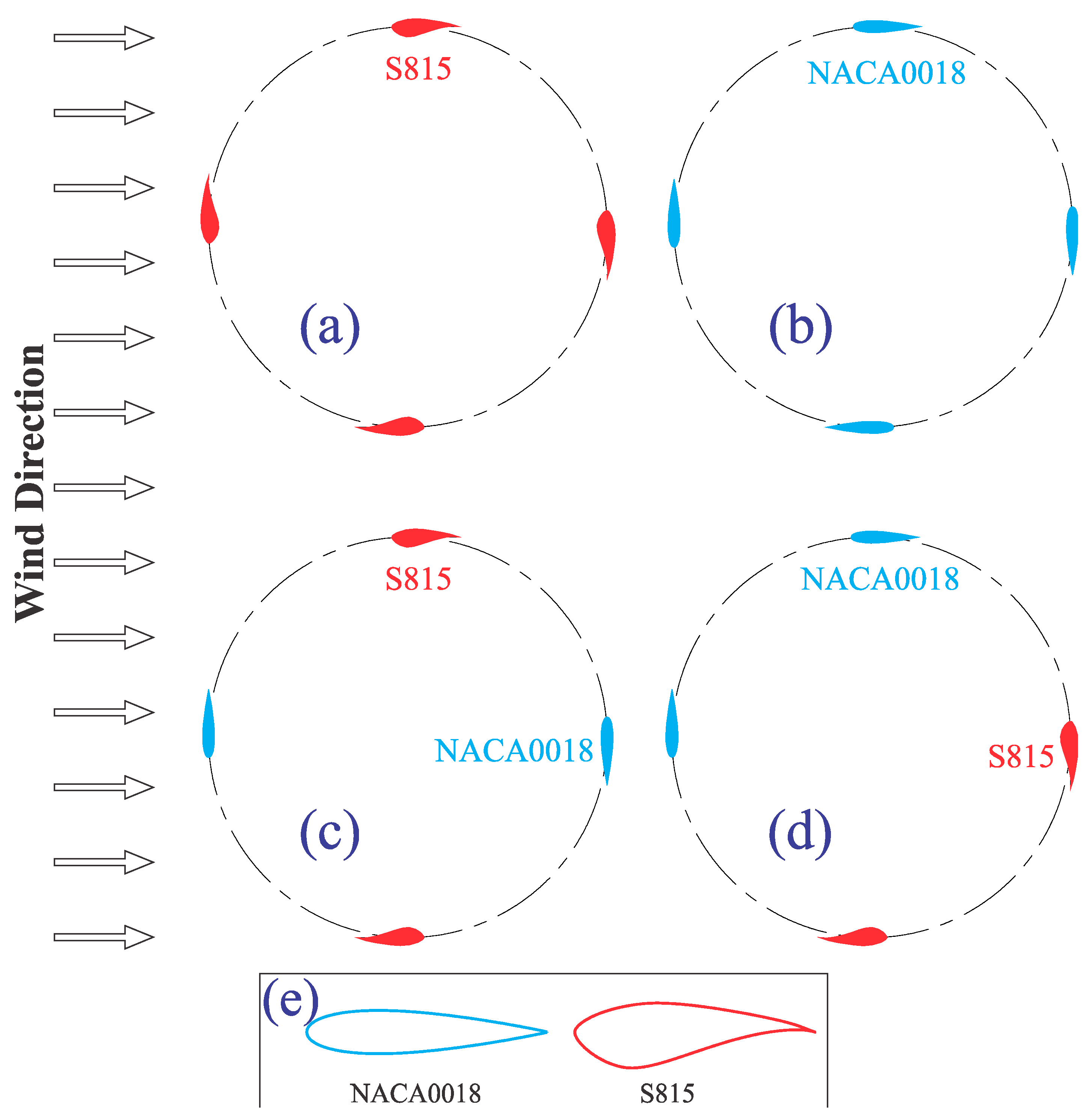

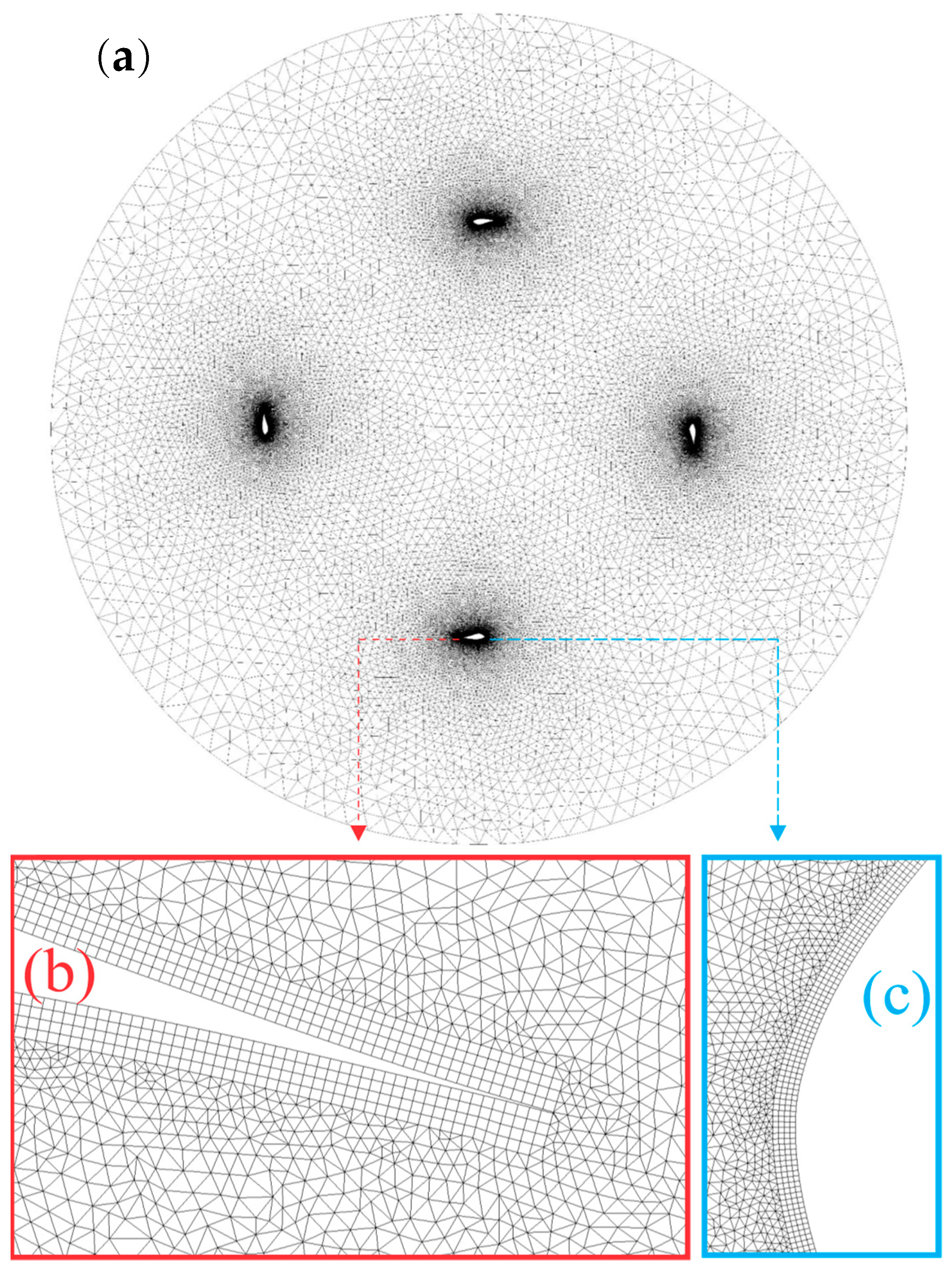

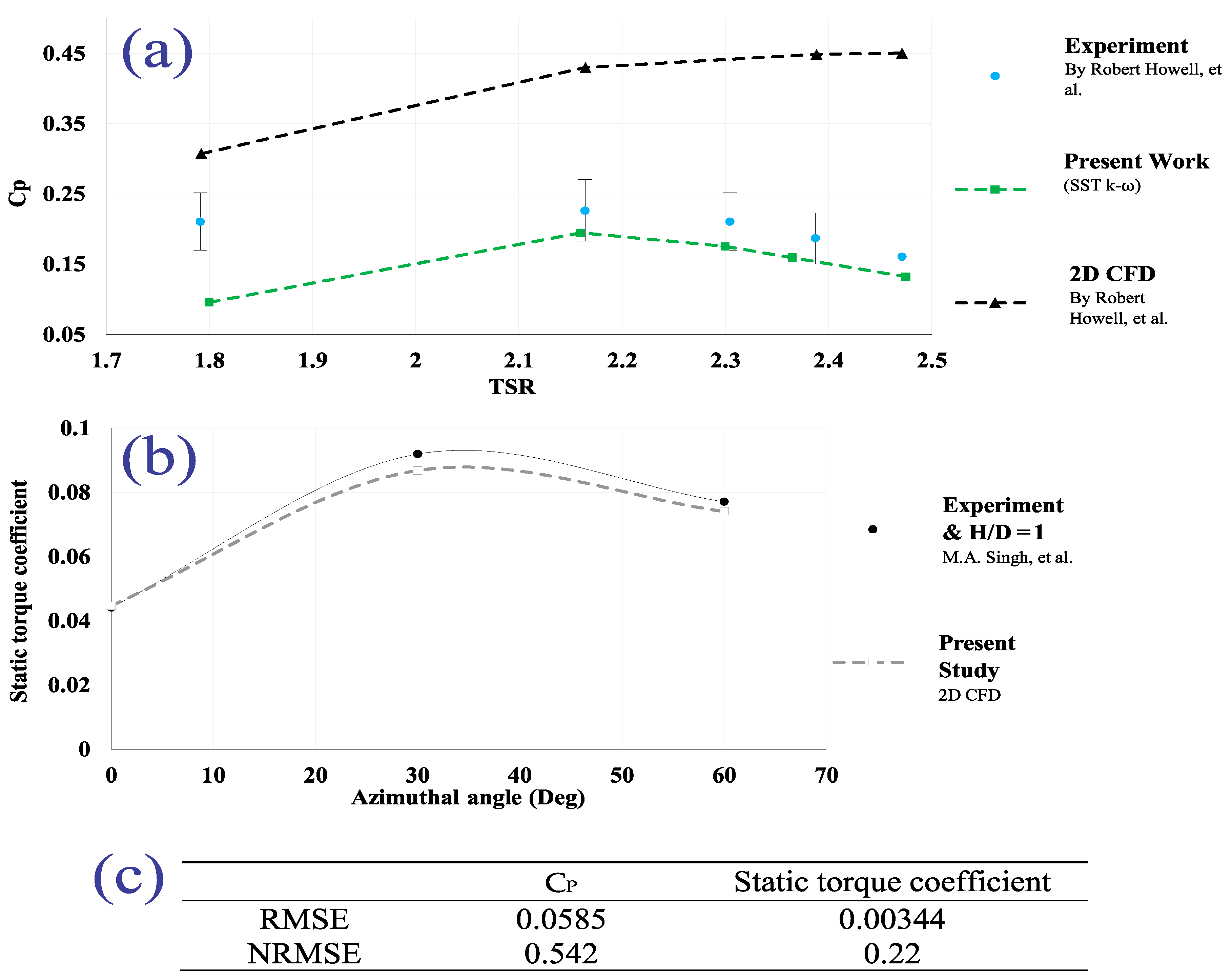
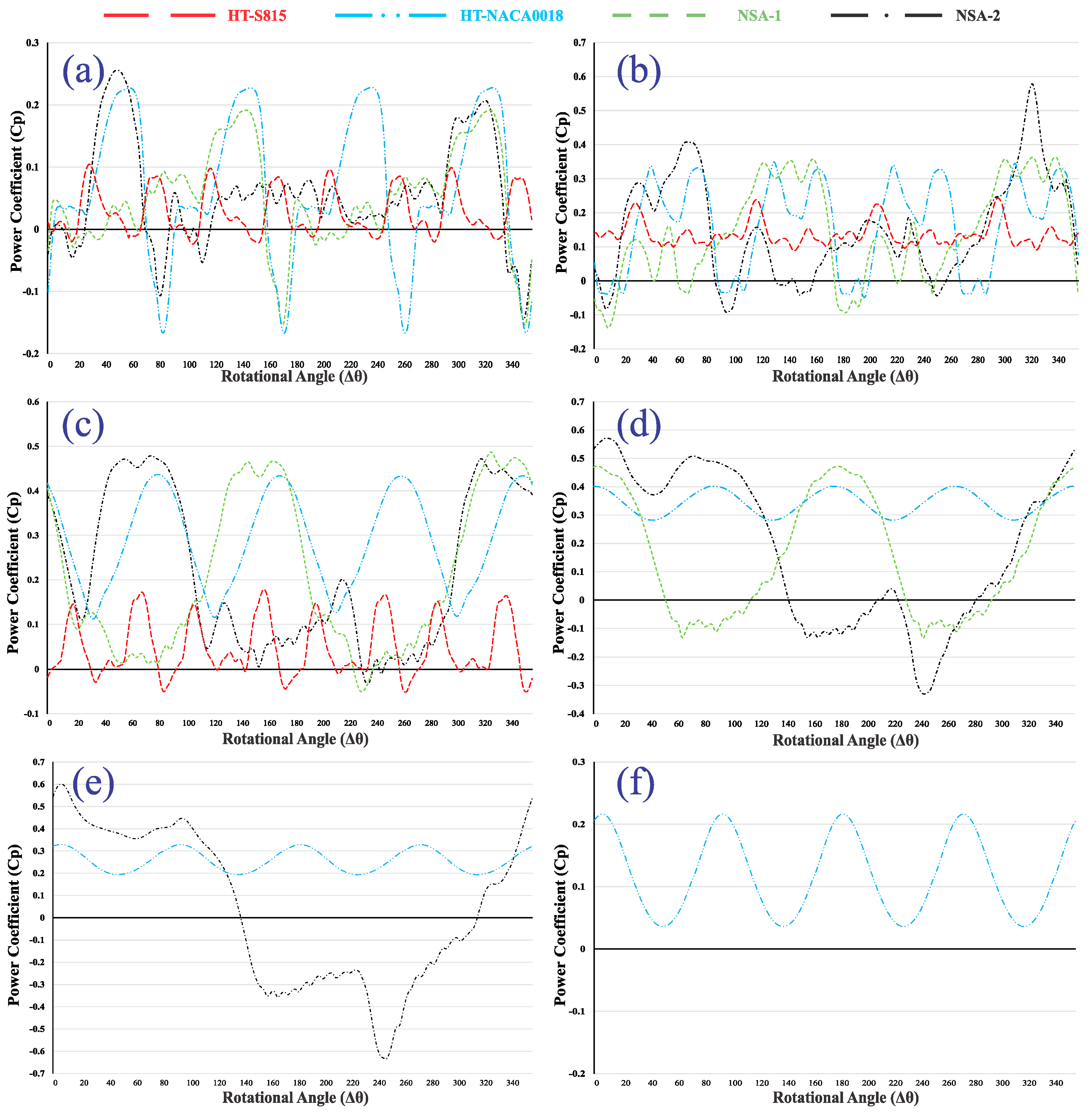
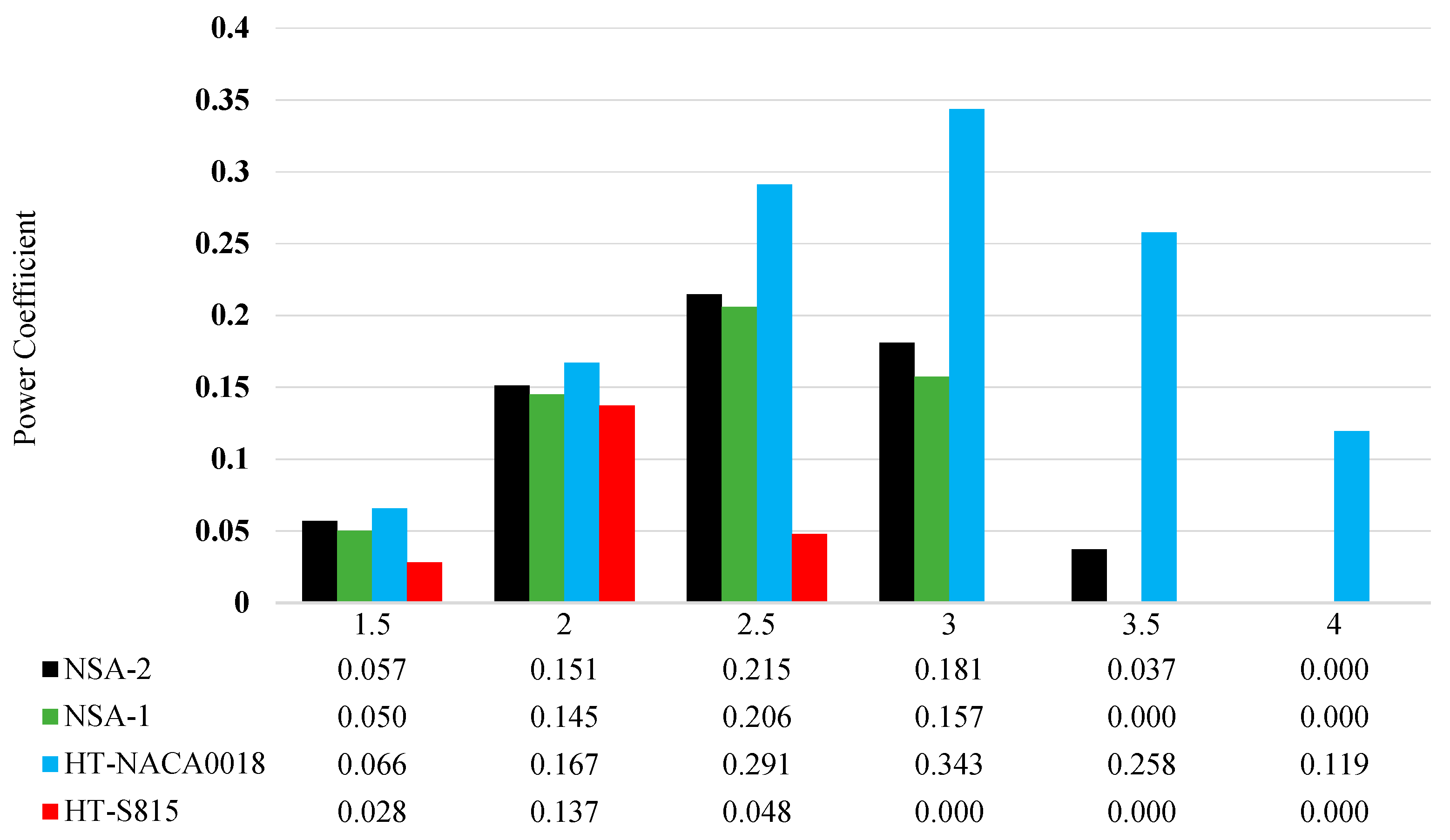


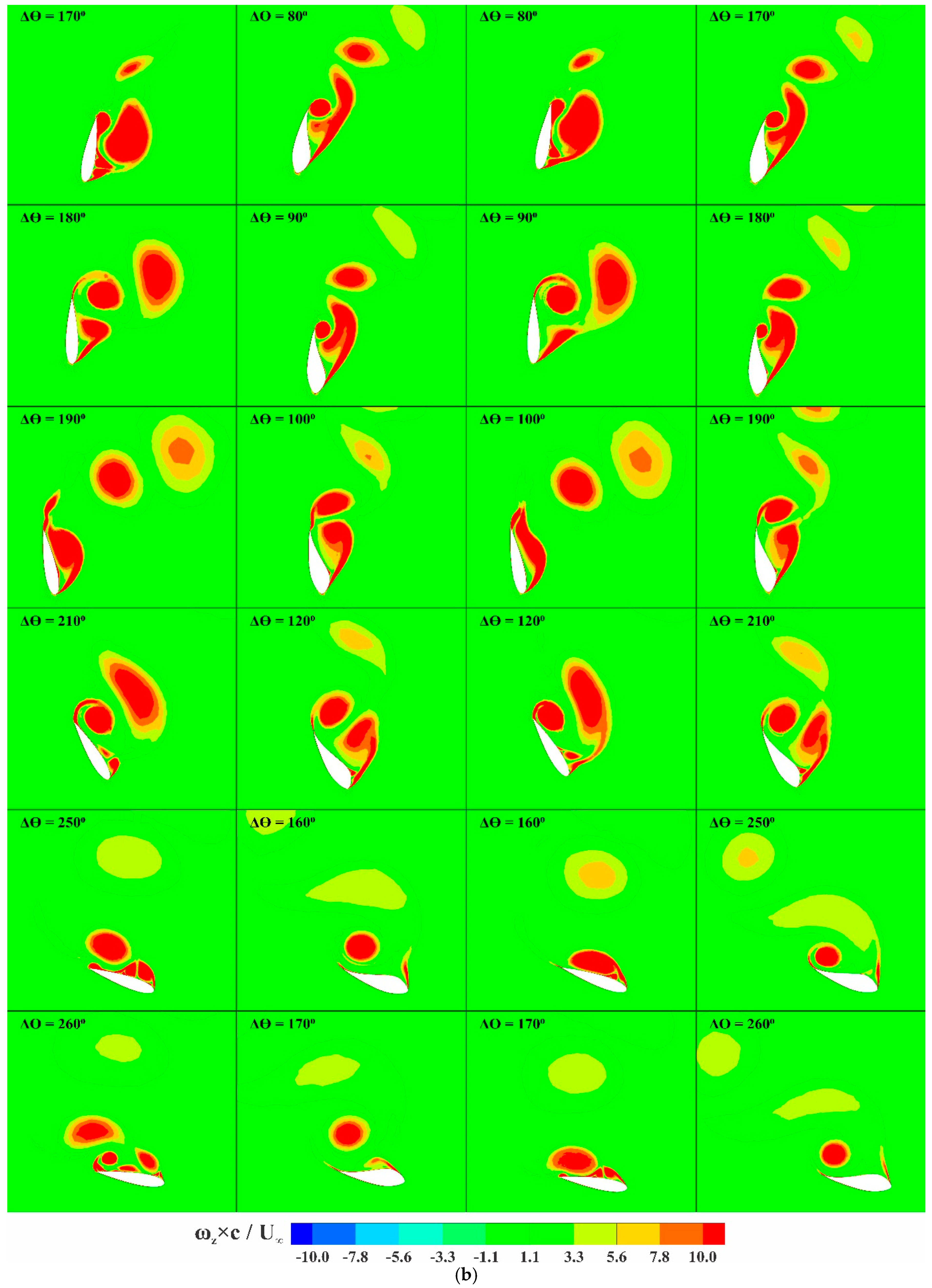
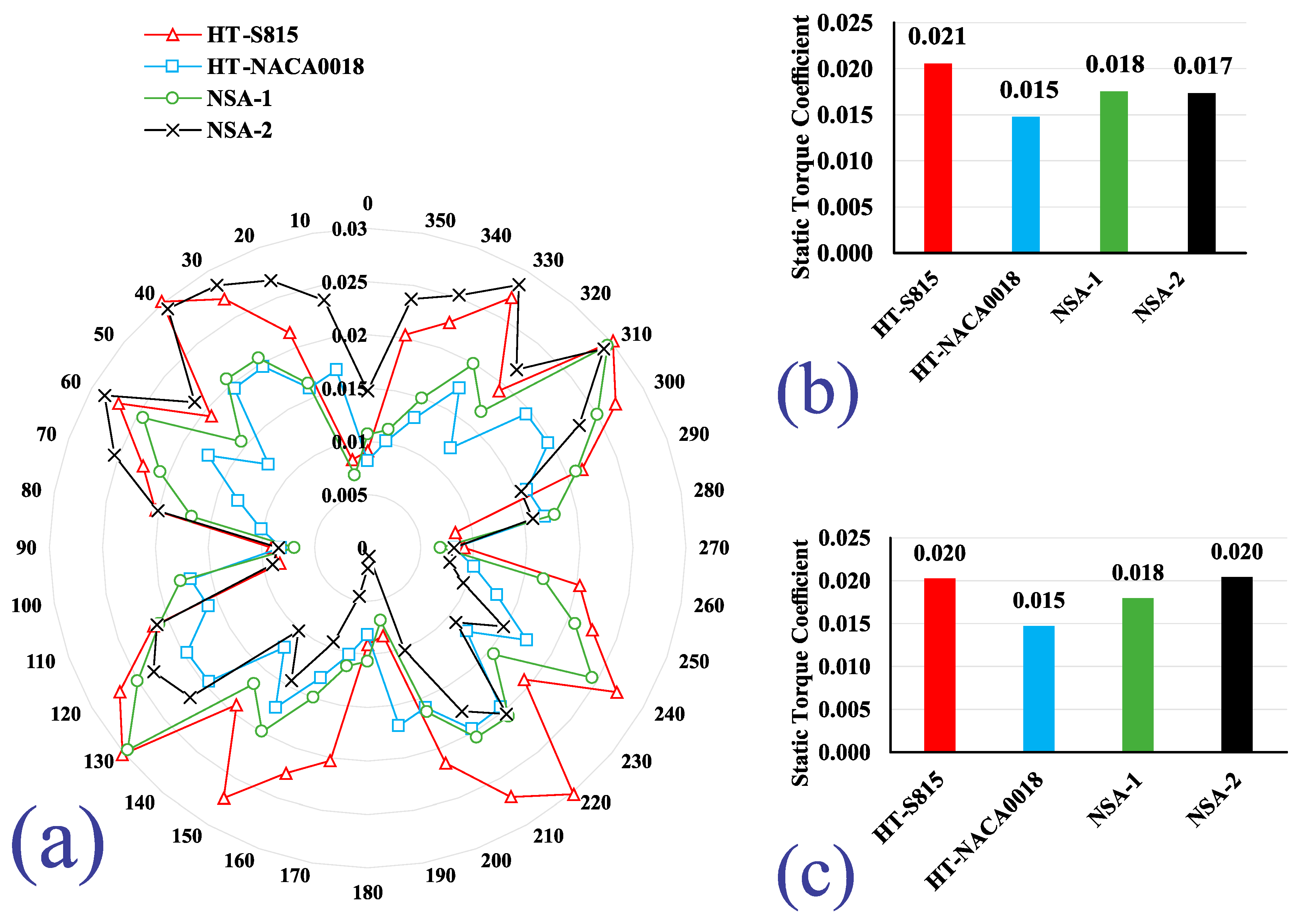
| Parameter | Symbol | Value | |
|---|---|---|---|
| Number of Blades | N | 4 | - |
| Chord Length | C | 0.075 | m |
| Rotor Radius | R (=D/2) | 0.59 | m |
| Rotor Height | H | 1.18 | m |
| Solidity | 0.254 | - | |
| Airfoils | - | NACA0018 and S815 | - |
| Rotational Velocity | 76 (constant) | Rad/s | |
| Wind Velocity | U∞ | 11.21 to 29.89 | m/s |
| Tip Speed Ratio | 1.5, 2, 2.5, 3, 3.5, 4 | - |
(−100° < θ < 140°) | (0° < ϴ < 360°) | (TSR = 2.5) | |
|---|---|---|---|
| NSA-2 vs. HT-NACA0018 | ↑ 33.3% | ↑ 13.3% | ↓ 26.1% |
| NSA-2 vs. HT-S815 | ~0 (equal) | ↓ 19% | ↑ 347.9% |
| NSA-1 vs. HT-NACA0018 | - | ↑ 20% | ↓ 29.2% |
| NSA-1 vs. HT-S815 | - | ↓ 14.3% | ↑ 329.1% |
| HT-NACA0018 vs. HT-S815 | - | ↓ 28.6% | ↑ 506% |
| HT-S815 vs. HT-NACA0018 | - | ↑ 40% | ↓ 83.5% |
Publisher’s Note: MDPI stays neutral with regard to jurisdictional claims in published maps and institutional affiliations. |
© 2021 by the authors. Licensee MDPI, Basel, Switzerland. This article is an open access article distributed under the terms and conditions of the Creative Commons Attribution (CC BY) license (https://creativecommons.org/licenses/by/4.0/).
Share and Cite
Maleki Dastjerdi, S.; Gharali, K.; Al-Haq, A.; Nathwani, J. Application of Simultaneous Symmetric and Cambered Airfoils in Novel Vertical Axis Wind Turbines. Appl. Sci. 2021, 11, 8011. https://doi.org/10.3390/app11178011
Maleki Dastjerdi S, Gharali K, Al-Haq A, Nathwani J. Application of Simultaneous Symmetric and Cambered Airfoils in Novel Vertical Axis Wind Turbines. Applied Sciences. 2021; 11(17):8011. https://doi.org/10.3390/app11178011
Chicago/Turabian StyleMaleki Dastjerdi, Sajad, Kobra Gharali, Armughan Al-Haq, and Jatin Nathwani. 2021. "Application of Simultaneous Symmetric and Cambered Airfoils in Novel Vertical Axis Wind Turbines" Applied Sciences 11, no. 17: 8011. https://doi.org/10.3390/app11178011
APA StyleMaleki Dastjerdi, S., Gharali, K., Al-Haq, A., & Nathwani, J. (2021). Application of Simultaneous Symmetric and Cambered Airfoils in Novel Vertical Axis Wind Turbines. Applied Sciences, 11(17), 8011. https://doi.org/10.3390/app11178011







